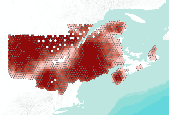|
|

This dataset depicts Wolf (Canis lupus) habitat in the Northern Appalachians predicted using the spatially explicit population model PATCH under the current habitat effectiveness plus low US mortality plus moderate Canadian mortality scenario (Carroll 2003). This dataset represents one of several scenarios testing the effects of habitat effectiveness and mortality rates on wolf populations. Static habitat suitability models for wolf were fed through PATCH to predict source and sink habitat areas across the landscape. The static models for wolf were created based on current and projected habitat effectiveness, which were based in part on road density and human population density. Wolf fecundity rates were based on...

This dataset depicts Wolf (Canis lupus) habitat in the Northern Appalachians predicted using the spatially explicit population model PATCH under the projected habitat effectiveness for 2025 plus moderate US mortality plus low Canadian mortality scenario (Carroll 2003). This dataset represents one of several scenarios testing the effects of habitat effectiveness and mortality rates on wolf populations. Static habitat suitability models for wolf were fed through PATCH to predict source and sink habitat areas across the landscape. The static models for wolf were created based on current and projected habitat effectiveness, which were based in part on road density and human population density. Wolf fecundity rates were...

This dataset depicts Marten (Martes americana) habitat in the Northern Appalachians predicted using the spatially explicit population model PATCH under the increased trapping intensity scenario (B4; Carrol 2007). This dataset represents one of several scenarios testing the interacting effects of trapping, timber harvest, habitat restoration, and climate change on marten populations. Static habitat suitability models for marten were fed through PATCH to predict source and sink habitat areas across the landscape. The static models for marten were created based on annual snowfall and percentage of older conifer and mixed forest. Demographic parameters were obtained from the literature and from calibration of the model....

This dataset depicts Lynx (Lynx canadensis) habitat in the Northern Appalachians predicted using the spatially explicit population model PATCH under the population cycling across the region plus trapping plus climate change scenario (FC2; Carrol 2007). This dataset represents one of several scenarios testing the interacting effects of population cycling, trapping, territory size, and climate change on lynx populations. Static habitat suitability models for lynx were fed through PATCH to predict source and sink habitat areas across the landscape. The static models for lynx were created based on a logistic regression model of reported lynx locations against the proportion of the landscape in deciduous forest cover...

This dataset depicts Wolf (Canis lupus) habitat in the Northern Appalachians predicted using the spatially explicit population model PATCH under the current habitat effectiveness plus high US mortality plus moderate Canadian mortality scenario (Carroll 2003). This dataset represents one of several scenarios testing the effects of habitat effectiveness and mortality rates on wolf populations. Static habitat suitability models for wolf were fed through PATCH to predict source and sink habitat areas across the landscape. The static models for wolf were created based on current and projected habitat effectiveness, which were based in part on road density and human population density. Wolf fecundity rates were based...

This dataset depicts Lynx (Lynx canadensis) habitat in the Northern Appalachians predicted using the spatially explicit population model PATCH under the population cycling only in Gaspe (core area) plus trapping scenario (B2; Carroll 2007). This dataset represents one of several scenarios testing the interacting effects of population cycling, trapping, territory size, and climate change on lynx populations. Static habitat suitability models for lynx were fed through PATCH to predict source and sink habitat areas across the landscape. The static models for lynx were created based on a logistic regression model of reported lynx locations against the proportion of the landscape in deciduous forest cover and annual...

This dataset depicts Marten (Martes americana) habitat in the Northern Appalachians predicted using the spatially explicit population model PATCH under the increased trapping Area scenario (B3; Carrol 2007). This dataset represents one of several scenarios testing the interacting effects of trapping, timber harvest, habitat restoration, and climate change on marten populations. Static habitat suitability models for marten were fed through PATCH to predict source and sink habitat areas across the landscape. The static models for marten were created based on annual snowfall and percentage of older conifer and mixed forest. Demographic parameters were obtained from the literature and from calibration of the model....

This dataset depicts Lynx (Lynx canadensis) habitat in the Northern Appalachians predicted using the spatially explicit population model PATCH under the population cycling only in Gaspe (core area) plus 36 square kilometer territory size (compared to 90 square kilometer territory) scenario (B136; Carroll 2007). This dataset represents one of several scenarios testing the interacting effects of population cycling, trapping, territory size, and climate change on lynx populations. Static habitat suitability models for lynx were fed through PATCH to predict source and sink habitat areas across the landscape. The static models for lynx were created based on a logistic regression model of reported lynx locations against...

This dataset depicts Marten (Martes americana) habitat in the Northern Appalachians predicted using the spatially explicit population model PATCH under the increased trapping area plus timber harvest scenario (L3; Carrol 2007). This dataset represents one of several scenarios testing the interacting effects of trapping, timber harvest, habitat restoration, and climate change on marten populations. Static habitat suitability models for marten were fed through PATCH to predict source and sink habitat areas across the landscape. The static models for marten were created based on annual snowfall and percentage of older conifer and mixed forest. Demographic parameters were obtained from the literature and from calibration...

This dataset depicts Marten (Martes americana) habitat in the Northern Appalachians predicted using the spatially explicit population model PATCH under the increased trapping intensity plus climate change scenario (FB4; Carrol 2007). This dataset represents one of several scenarios testing the interacting effects of trapping, timber harvest, habitat restoration, and climate change on marten populations. Static habitat suitability models for marten were fed through PATCH to predict source and sink habitat areas across the landscape. The static models for marten were created based on annual snowfall and percentage of older conifer and mixed forest. Demographic parameters were obtained from the literature and from...

This dataset depicts Marten (Martes americana) habitat in the Northern Appalachians predicted using the spatially explicit population model PATCH under the increased trapping intensity plus timber harvest scenario (L4; Carrol 2007). This dataset represents one of several scenarios testing the interacting effects of trapping, timber harvest, habitat restoration, and climate change on marten populations. Static habitat suitability models for marten were fed through PATCH to predict source and sink habitat areas across the landscape. The static models for marten were created based on annual snowfall and percentage of older conifer and mixed forest. Demographic parameters were obtained from the literature and from calibration...

This dataset depicts Marten (Martes americana) habitat in the Northern Appalachians predicted using the spatially explicit population model PATCH under the increased survival in parks scenario (B1; Carrol 2007). This dataset represents one of several scenarios testing the interacting effects of trapping, timber harvest, habitat restoration, and climate change on marten populations. Static habitat suitability models for marten were fed through PATCH to predict source and sink habitat areas across the landscape. The static models for marten were created based on annual snowfall and percentage of older conifer and mixed forest. Demographic parameters were obtained from the literature and from calibration of the model....

This dataset depicts Lynx (Lynx canadensis) habitat in the Northern Appalachians predicted using the spatially explicit population model PATCH under the no population cycling scenario (A1; Carrol 2007). This dataset represents one of several scenarios testing the interacting effects of population cycling, trapping, territory size, and climate change on lynx populations. Static habitat suitability models for lynx were fed through PATCH to predict source and sink habitat areas across the landscape. The static models for lynx were created based on a logistic regression model of reported lynx locations against the proportion of the landscape in deciduous forest cover and annual snowfall. Demographic parameters were...

This dataset depicts Wolf (Canis lupus) habitat in the Northern Appalachians predicted using the spatially explicit population model PATCH under the projected habitat effectiveness for 2025 plus low US mortality plus moderate Canadian mortality scenario (Carroll 2003). This dataset represents one of several scenarios testing the effects of habitat effectiveness and mortality rates on wolf populations. Static habitat suitability models for wolf were fed through PATCH to predict source and sink habitat areas across the landscape. The static models for wolf were created based on current and projected habitat effectiveness, which were based in part on road density and human population density. Wolf fecundity rates were...

This dataset depicts Wolf (Canis lupus) habitat in the Northern Appalachians predicted using the spatially explicit population model PATCH under the projected habitat effectiveness for 2025 plus moderate US mortality plus high Canadian mortality scenario (Carroll 2003). This dataset represents one of several scenarios testing the effects of habitat effectiveness and mortality rates on wolf populations. Static habitat suitability models for wolf were fed through PATCH to predict source and sink habitat areas across the landscape. The static models for wolf were created based on current and projected habitat effectiveness, which were based in part on road density and human population density. Wolf fecundity rates...

This dataset depicts Marten (Martes americana) habitat in the Northern Appalachians predicted using the spatially explicit population model PATCH under the increased survival in parks plus timber harvest scenario (L1; Carrol 2007). This dataset represents one of several scenarios testing the interacting effects of trapping, timber harvest, habitat restoration, and climate change on marten populations. Static habitat suitability models for marten were fed through PATCH to predict source and sink habitat areas across the landscape. The static models for marten were created based on annual snowfall and percentage of older conifer and mixed forest. Demographic parameters were obtained from the literature and from calibration...

This dataset depicts Marten (Martes americana) habitat in the Northern Appalachians predicted using the spatially explicit population model PATCH under the current trapping rates plus forest restoration plus climate change scenario (FR2; Carrol 2007). This dataset represents one of several scenarios testing the interacting effects of trapping, timber harvest, habitat restoration, and climate change on marten populations. Static habitat suitability models for marten were fed through PATCH to predict source and sink habitat areas across the landscape. The static models for marten were created based on annual snowfall and percentage of older conifer and mixed forest. Demographic parameters were obtained from the literature...

This dataset depicts Marten (Martes americana) habitat in the Northern Appalachians predicted using the spatially explicit population model PATCH under the current trapping rates plus timber harvest plus climate change scenario (FL2; Carrol 2007). This dataset represents one of several scenarios testing the interacting effects of trapping, timber harvest, habitat restoration, and climate change on marten populations. Static habitat suitability models for marten were fed through PATCH to predict source and sink habitat areas across the landscape. The static models for marten were created based on annual snowfall and percentage of older conifer and mixed forest. Demographic parameters were obtained from the literature...

This dataset depicts Lynx (Lynx canadensis) habitat in the Northern Appalachians predicted using the spatially explicit population model PATCH under the population cycling only in Gaspe (core area) scenario (B1; Carroll 2007). This dataset represents one of several scenarios testing the interacting effects of population cycling, trapping, territory size, and climate change on lynx populations. Static habitat suitability models for lynx were fed through PATCH to predict source and sink habitat areas across the landscape. The static models for lynx were created based on a logistic regression model of reported lynx locations against the proportion of the landscape in deciduous forest cover and annual snowfall. Demographic...

This dataset depicts Wolf (Canis lupus) habitat in the Northern Appalachians predicted using the spatially explicit population model PATCH under the current habitat effectiveness plus moderate US mortality plus high Canadian mortality scenario (Carroll 2003). This dataset represents one of several scenarios testing the effects of habitat effectiveness and mortality rates on wolf populations. Static habitat suitability models for wolf were fed through PATCH to predict source and sink habitat areas across the landscape. The static models for wolf were created based on current and projected habitat effectiveness, which were based in part on road density and human population density. Wolf fecundity rates were based...
|
|